Capital Structure
©P.V. Viswanath, 1997, 1999, 2000, 2007
Tradeoffs and Theory
- Perfect Markets View: Modigliani-Miller Irrelevance Theorem
- Advantages of Debt
- Disadvantages of Debt
- Factors that explain cross-sectional variations in debt-equity ratios
- How stockholders can expropriate bondholder wealth by choosing riskier projects
- An option model of bondholder-stockholder relations
- How stockholders can expropriate shareholder wealth by increasing leverage
- The Problem of Debt Overhang
- A State Space Approach to Asset Pricing and Capital Structure
- Example of a Debt Covenant from Honeywell International Inc.
Models and Applications: Cost of Capital Approach
Capital Structure Problem and Solution
Perfect Markets View:
Modigliani
and Miller Capital Structure Irrelevance Proposition I:
If there are no leakages (i.e. payouts to parties other than the security holders of the firm that are a function of capital structure), then:
-
The value of a company derives from the operations of the company.
-
Changes in capital structure only affect the way in which the distribution of the cash flows between stockholders and bondholders is achieved.
Hence
the value of the firm should be independent of its capital structure.
However,
it may be possible to earn a premium for supplying a security or capital structure
policy that is in short supply (financial clienteles).
Arbitrage-based proof:
Companies
Allais (A) and Blackburn (B) differ only in their capital structure.
A is financed 20% debt and 80% equity; B is financed 10% debt and 90%
equity. Nguyen owns 1% of Allais'
common stock.
With his current
portfolio (call it X), his cashflows each year equal 0.01(C-IntA),
where IntA is the total interest
paid out in that year by A (may differ from the promised payment), and C is
the total operating cashflow that year for A (and B).
This portfolio will have a value of .01(0.8VA)
= 0.008 VA. Alternatively,
he could buy 1% of B's debt and 1% of B's equity, and borrow an amount equal
to .01DA, where DA
= 0.2VA is the market
value of A's debt (portfolio Y). If
he puts up his interest in B as collateral, he can obtain the same borrowing
terms as firm A. This would give
him a cashflow of 0.01C - 0.01IntA,
which is the same as he gets by holding 1% of A's stock.
The market value of this alternative package is 0.01VB
- .01(.2VA).
| Portfolio |
Cash flow |
Value |
| X |
0.01(C-IntA) |
0.008 VA |
| Y | 0.01(C-IntA) |
.01VB - .01(.2VA) |
If VA = VB, then the wealth required to create the two portfolios is equal. If, on the other hand, VA > VB, Nguyen can shortsell portfolio X, and buy portfolio Y. This would create a portfolio with zero cashflows each year, but there would be 0.002(VA-VB) > 0 left over from the transaction, which would be pure arbitrage profit. Hence, in a properly functioning arbitrage-free market VA = VB, and the value of a firm is independent of its capital structure.
MM Proposition II: The required return on equity is a linear function of the debt-equity ratio.
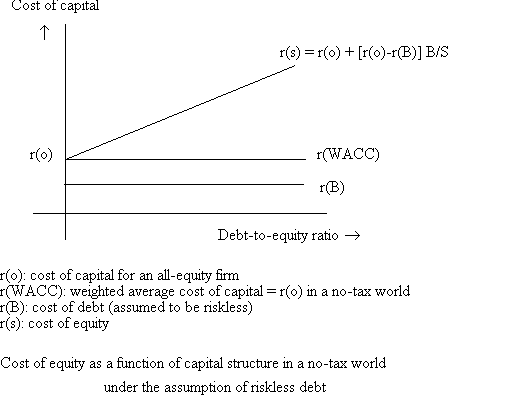
MM Proposition II with risky debt:
Consider the following
firm with a given probability distribution of terminal firm value at the end
of the year and the relevant state prices in the economy.
| State of the World/Scenario |
State price |
|
|
| 1 |
|
0.1 |
|
| 2 |
0.16 |
|
|
| 3 |
|
|
|
| 4 |
|
|
|
| 5 |
|
|
|
| 6 |
|
|
|
A
state price is the market price of the relevant state security, i.e. a security
with a payoff of $1 in that state and zero otherwise.
Now suppose this firm has outstanding debt has a face value of $30 and matures in one year. Then the payoffs to the debtholders can be computed as follows:
| State price | Probability | Cashflow to firm | Cashflow to debtholders | Cashflow to equityholders |
| 0.08 | 0.1 | 100 | 30 | 70 |
| 0.16 | 0.22 | 80 | 30 | 50 |
| 0.28 | 0.3 | 60 | 30 | 30 |
| 0.19 | 0.2 | 50 | 30 | 20 |
| 0.09 | 0.1 | 30 | 30 | 0 |
| 0.09 | 0.08 | 20 | 20 | 0 |
| E(cashflow) |
60.2 |
29.2 | 31 | |
| Price | 51.6 | 25.8 |
25.8 |
|
| E(return) | 16.67% | 13.18% |
20.16% |
Hence, if we try to check up on the formula from MM II: E(Requity) = E(Rassets) + [E(Rassets)-E(Rdebt)](D/E), the RHS works out to 16.67 + (16.67 - 13.18)(25.8/25.8) = 16.67 + 3.49 = 20.16.
We
can go through a similar computation for each level of debt. This
generates the expected return relationships between debt, equity and the entire
firm, consistent with Modigliani-Miller Proposition II.
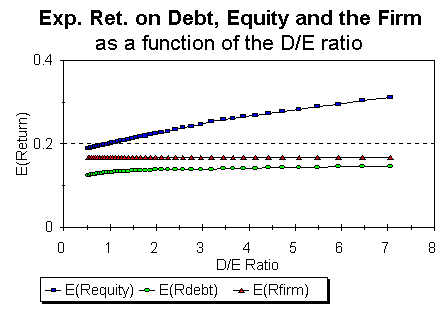
Why choose debt or equity to finance projects?
- Tax advantages of debt
- the debt ratios of entities facing higher (marginal) tax rates should be higher than those facing lower marginal tax rates.
- Firms with substantial non-debt tax shields, such as depreciation, should be less likely to use debt than those firms that do not have such tax shields.
- If (marginal) tax rates rise over time, we would expect debt ratios to go up as well.
- Firms in countries where debt has a greater tax benefit would be expected to have higher debt ratios.
- Discipline characteristics of debt
Costs of debt:
- Ownership and management are separated in the corporate form of government. Hence, in spite of the theoretical ability of stockholders to control the firm, in practice, stockholders have difficulty in controlling entrenched management. The amount of time for which funds raised through debt is limited; hence the manager has to go back to the markets to justify the continued use of those funds. Firms with a lot of free cash flow (operating cash flows after taxes but before discretionary capital expenses) provide a cushion to their managers, who have funds available with a minimal need to justify the way in which those funds are used.
- Expected Bankruptcy Costs. If borrowing money increases the probability of bankruptcy and bankruptcy involves expenditure of resources, then ceteris paribus, it is better for all concerned that money be raised through equity financing rather than through borrowing. Obviously we are interested not only in the actual costs of bankruptcy if it should occur, but also the probability of bankruptcy.
- Factors affecting the probability of bankruptcy:
- size of operating cash flows relative to debt obligations
- variance of operating cash flows.
- The actual costs incurred in the event of bankruptcy or financial distress
- Direct Costs (Legal costs, costs due to illiquidity of assets in case of need to liquidate company).
- Indirect Costs (also known as financial distress costs)
- Firms that sell the promise of future servicing/future products along with the actual product, whether such servicing/products are supplied by the firm itself or by others.
- Firms that provide goods or services whose quality cannot be determined easily in the short run.
- Agency costs of debt -- the conflict between bondholders and stockholders
- Manifested in three ways:
- Choice of investments -- choosing riskier projects
- Financing decisions -- choosing more debt instead of equity to dilute existing debtholder claims
- Dividend decisions -- paying higher dividends to reduce the asset base from which debtholder claims are paid.
- To protect themselves, bondholders either
- incur the costs of monitoring directly (which reduces the amount they are willing to pay for debt securities) or
- demand debt covenants, which reduce managerial flexibility.
The question of debt versus equity is more relevant for
the financing of assets that are long-term; for short-term assets, it makes
more sense to finance them short-term, given the notion of asset-liability
matching. For example, accounts receivable would be financed with short-debt,
such as bank loans, or commercial paper, or with other short-term liabilities,
such as accounts payable. Equity is not generally relevant, in any case.
| Factor class | Firm/Industry Characteristics | More debt or less debt |
| I: Tax advantages of debt | Earnings Volatility | The more volatile earnings are, the more likely is it, that interest deductions cannot be taken in a particular year. This means that the present value of the deductions are lost, even if they are ultimately taken in a later year. |
| Tax status | If a firm has accumulated losses, it will not be able to take interest deductions. | |
| The existence of non-debt tax deductions | If there are non-debt tax deductions, such as depreciation, there will less of a need/ability to use interest deductions. | |
| II: Discipline characteristics of debt | Are there other ways in which manager's objectives are aligned with those of stockholders', such as stock options? | If stock options exist, debt is not as necessary for purposes of disciplining managers |
| Does the firm have a high dividend payout ratio? | Dividends work, to some extent, as substitutes for debt, in this respect. | |
| III: Expected Bankruptcy Costs | ||
| a. Actual Bankruptcy Costs and Financial Distress Costs | Whether the firm's assets are specialized or not | The more specialized the assets are, the less likely that they will fetch their market value in a short time, in the event of liquidation; hence the more specialized assets are, the less debt they can support. |
| The ratio of tangible to non-tangible assets | Tangible assets are more liquid, and hence more desirable in the event of liquidation; hence the more tangible assets are, the more debt they can support. | |
| The durable nature of the firm's goods | The more durable the firm's goods are, the more likely that its customers will take into account the likelihood of the firm's continued existence to provide repairs and other services, in their initial decision to purchase the goods; hence the more durable the goods are, the less desirable is debt. | |
| How difficult it is for customers to evaluate the quality of the firm's goods. | The more difficult it is to evaluate the quality of the firm's goods, the more likely that the firm will have to underprice in the beginning, until it has built up a reputation; obviously, then, the firm wants to be around to capitalize on the quality of its products. This means that less debt is indicated. | |
| b. Probability of Bankruptcy | Earnings Volatility | The more volatile earnings are, the more likely bankruptcy is, independent of the level of debt. |
| IV: Agency Costs of Debt | Nature of industry: need for flexibility | If flexibility is needed, debt is contraindicated; hence growth firms, which probably need flexibility, should have less debt. |
How stockholders can expropriate bondholder wealth
by choosing riskier projects
Example 1:
The manager of the firm, acting on behalf of the equity holders, has an incentive to take unduly risky projects. Consider these two projects faced by a firm with a promised payment of $500,000 to debtholders. The details of the projects and the resulting payoffs to the firm, to bondholders, and to stockholders are provided in the tables below:
Payoff to the firm
| Prob. | Project 1 | Project 2 | |
| State 1 | 0.5 | $600,000 | $1,000,000 |
| State 2 | 0.5 | $600,000 | $0 |
| Expected Value | $600,000 | $500,000 |
Payoff to the equityholders
| Prob. | Project 1 | Project 2 | |
| State 1 | 0.5 | $100,000 | $500,000 |
| State 2 | 0.5 | $100,000 | $0 |
| Expected Value | $100,000 | $250,000 |
Payoff to the bondholders
| Prob. | Project 1 | Project 2 | |
| State 1 | 0.5 | $500,000 | $500,000 |
| State 2 | 0.5 | $500,000 | $0 |
| Expected Value | $500,000 | $250,000 |
Under the circumstances, it is obvious that stockholders will choose Project 2 to the detriment of bondholders, and decrease firm value. On the other hand, bondholders will tend to take unduly conservative actions because they don't get compensated even if they increase the value of the firm.
In addition to the transfer of wealth between
the two parties, what we see from the above example that is that both parties
could end up losing, because the value of the firm as a whole could suffer.
Another source of value loss is the additional expenditures that bondholders
are forced to incur to prevent from being dispossessed by stockholders. These
two kinds of value loss represent agency costs of debt.
Example 2: The impact of agency costs of debt on choice of financing can be seen in this example as well.
A firm with the opportunity to invest
in three different projects is considering the issuance of debt with a face
value of $1600.
Suppose the state prices of all the states are the
same, presumably because investors are risk-neutral (implying a risk-free
interest rate of 6%). Here are the details of the projects.
Payoffs on different projects
| Scenario | 1 | 2 | 3 | State Price | ||||||
| Proj flow | Eq flow | Debt flow | Proj flow | Eq flow | Debt flow | Proj flow | Eq flow | Debt flow | ||
| 1 | 1000 | 0 | 1000 | 400 | 0 | 400 | 0 | 0 | 0 | 0.188679 |
| 2 | 1500 | 0 | 1500 | 1150 | 0 | 1150 | 900 | 0 | 900 | 0.188679 |
| 3 | 2000 | 400 | 1600 | 1900 | 300 | 1600 | 1800 | 200 | 1600 | 0.188679 |
| 4 | 2500 | 900 | 1600 | 2650 | 1050 | 1600 | 2700 | 1100 | 1600 | 0.188679 |
| 5 | 3000 | 1400 | 1600 | 3400 | 1800 | 1600 | 3600 | 2000 | 1600 | 0.188679 |
| Exp. Payoff | 2000 | 540 | 1460 | 1900 | 630 | 1270 | 1800 | 660 | 1140 | |
| Price | 1886.792 | 509.434 | 1377.358 | 1792.453 | 594.3396 | 1198.113 | 1698.113 | 622.6415 | 1075.472 | |
From the equityholders' point of view, project 3 is most desirable, followed by project 2, then project 1. The ranking of the projects is exactly the opposite for debtholders. If the additional required investment for each project is $1200, then debt is a viable option only if project 1 can be guaranteed to be chosen. If monitoring is too expensive, then equity financing will be chosen over debt financing, since debtholders will only be willing to pay $1075.472 for debt with a face-value of debt. In order to raise more than that amount, equityholders would have to raise the face value of the debt.
If, for whatever reason, debt is chosen (and monitoring is sufficiently expensive that equityholders cannot be forced to pick project 1), then the debt can be sold for $1075.472 only, and furthermore, there will be a net loss of $200 over the first-best project. If the cost of monitoring is $100, then debt can still be chosen. If the cost of monitoring is $200, then equity will be chosen. Hence, firms with projects such that monitoring costs are low and firms who have few projects to choose from, will tend to have more debt than equity in their capital structure.
An option model of bondholder-stockholder relations
In order to highlight the relationship between bondholders and stockholders, it is useful to think of the firm's securities as contingent claims. Assume that the firm is expected to last exactly one period, from today (time t=0) to tomorrow (t=1). The firm issues debt with a promised repayment of $F at time 1. Let X be the value of the entire firm at t = 1. Then the payoff to debtholders at t=1 can be rewritten as Min(F,X), while the payoff to equityholders is Max(X-F,0).
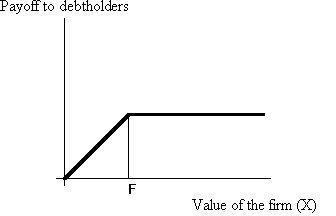
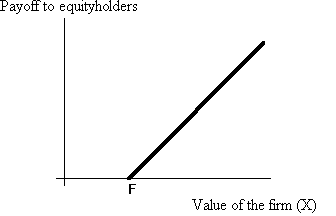
The payoff to the entire firm, X, is distributed between bondholders and stockholders, as below:
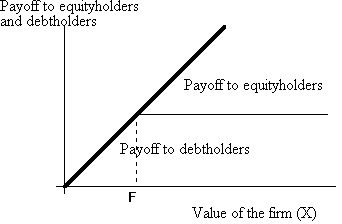
The form of the payoff function to stockholders
is exactly the same as the payoff to an investor holding an American call
option on an underlying asset with a terminal value of X, and an exercise
price of $F. Just as the value of the call option is increasing in the volatility
of returns on the underlying asset, so also is the value of the equity increasing
in the volatility of returns on the firm's underlying projects, which generate
the $X. Hence, stockholders have an incentive, ceteris paribus, to choose
riskier projects.
How stockholders can expropriate shareholder wealth by increasing leverage
Suppose Ventura Productions has the following
balance sheet:
| Assets | Liabilities | ||
| Property, Plant and Equipment | 1000 | Equity | 1000 |
| Total | 1000 | Total | 1000 |
At this point, recognizing that interest payments are
tax-deductible, Ventura decides to issue $500 worth of debt, with a coupon
equal to the yield to maturity required by the market; the debt, thus, trades
at par. For convenience, let us assume that the debt is 30 year debt
with a yield of 8%. These funds are used to buy new assets. Assume, further,
that Ventura has been able to convince the buyers of its bonds that it has
no plans to issue further debt. Bondholders recognizing that this leaves
them with $3 of assets for every dollar of debt, are satisified with the deal,
and the yield that they are now obtaining. Unfortunately, they have
not been careful to require Ventura to put its promise of no further debt
issues into the bond indenture.
| Assets | Liabilities | ||
| Property, Plant and Equipment | 1500 | Equity | 1000 |
| Debt | 500 | ||
| Total | 1500 | Total | 1500 |
Now, suppose that Ventura has a change of CEO. This guy realizes that there is a potential for increasing the value of shareholder equity, proposes a further issue of debt, to the tune of another $1000. These new bondholders are much cannier than the previous lot, having seen what happened to the firm's promises to previous bondholders. Consequently, they require Ventura to put a clause in the bond indenture, preventing it from issuing any further debt. Of course, the new bondholders, who have the same prority rights as the previous bondholders realize that they only have 2500/1500 or $1.6 of assets for every dollar of debt. Consequently, they insist upon a much higher coupon rate, which is again designed to ensure that the new bonds begin trading at par. Suppose the new bond yield is 10%.
However, what happens to the price of the original bonds?
The original bonds are no less riskier than the new bonds; hence investors
in those bonds will now require the same yield as the new bondholders, i.e.
10%. But the coupon rate on the old bonds are lower -- only 8%; consequently,
they must trade at a discount. In other words, the old bonds suffer
a loss in value (which works out to 94.27). Keep in mind, though, that
the total value of all liabilities (debt and equity) must be $2500, since
that is the value of all assets. The decrease in value of the old bonds
must therefore mean a corresponding increase in value of the equity of the
same amount.
| Assets | Liabilities | ||
| Property, Plant and Equipment | 2500 | Equity | 1094.27 |
| Old debt | 405.73 | ||
| New debt | 1000 | ||
| Total | 2500 | Total | 2500 |
As must be obvious from this example, the unforeseen increase in leverage allowed shareholders to expropriate bondholders.
Cost of Capital ApproachThe Weighted-Average Cost of Capital is defined as
The value of the firm is the discounted present value of after-tax cash flows to the firm, where the cash flows are defined as EBIT(1-t) - (Capital Expenditures - Depreciation) - Change in Non-cash Working Capital. (Note that tax effects of capital structure decisions such as deduction of interest payments is not taken into account here, because those effects are taken into account in terms of a reduced after-tax cost of debt.)
If we can assume that the cashflows as defined above are not affected by the capital structure decision, then maximizing the value of the firm is equivalent to minimizing the weighted-average cost of capital. However, if operating cashflows will be affected by capital structure, perhaps due to financial distress costs, then the appropriate procedure is to discount the cashflows by the weighted-average cost of capital and pick the capital structure that maximizes firm value.
The first step in any case is to compute the costs of debt and equity for different levels of the debt ratio (D/D+E+PS).
If we use the CAPM to obtain the required rate of return on equity, we can compute the levered equity beta for different levels of debt by using the following method:
To estimate the firm's cost of debt at different levels of debt, the procedure involves creating two schedules, one giving the relationship between a measure of default risk and a firm's underlying characteristics, including debt ratios; and the second, relating that measure of default risk to market required rates of return. The two schedules are used in tandem to relate debt ratios to costs of debt.
- Obtain an estimate of the current beta and the current debt-equity ratio.
- Unlever the current beta, using the formula:
- Compute the levered beta for different levels of debt using the formula
.
- Use the CAPM to get the required rate of return on equity for the different debt levels.
Points to note:
- Prepare the latest income statement showing the current operating income and relevant financial ratios.
- Compute the market value of the firm: Market Value of firm = Market Value of Equity + Market Value of Debt.
- For different levels of the debt ratio, compute the dollar value of debt
- Dollar Value of Debt = [D/(D+E)]*Current Market Value of Firm
- Compute the amount that will be paid as interest (Interest Rate *Dollar Value of Debt) and the financial ratios at each new debt ratio.
- Using the schedule that relates bond ratings to financial ratios, estimate what the firm's rating would be at each new debt ratio and the market interest rate that would correspond to that ration; this is the before-tax cost of debt.
- The after-tax cost of debt is computed as (1-t)*(Before Tax Cost of Debt).
- Effective tax rate = Statutory Rate*
 .
Keep in mind, however, that this correction is only an approximation to
the true effective tax rate. We might also want to do sensitivity
analysis to take into account the possibility that there might be huge swings
in operating income, which would impact the firm's ability to use the tax
benefits of debt.
.
Keep in mind, however, that this correction is only an approximation to
the true effective tax rate. We might also want to do sensitivity
analysis to take into account the possibility that there might be huge swings
in operating income, which would impact the firm's ability to use the tax
benefits of debt. - At what interest level do we assume that the debt is refinanced? Is it at the market rate? This might be the correct assumption if investors have protective puts that allow them to have their debt refinanced at the prevailing market rates. On the other hand, if bondholders are not protected from the dispossessive effects of capital structure changes, then we should assume that when debt is increased, the current rates on existing bonds are locked in.
Cautionary factors:
- The lookup table may not be the same for all industries. A certain Interest Coverage Ratio may be interpreted more benignly if the variance of operating income is lower. Similarly, the asset quality of all industries is not the same. If this factor is important, then the lookup table should be modified according to the industry.
- Operating Income might be affected by changes in the capital structure of the firm. This would be the case, for example, of the pernicious effects of operating at levels where the probability of bankruptcy is high. However, a drop in bond rating might affect operating income if it affected the willingness of trade creditors to provide credit. If customers of firms selling durable goods take the firm's debt ratio into account, as hypothesized above, once again, operating income will be affected.
- There might be other factors to take into account in the analysis. For example, the firm's CFO might want to keep the firm's credit rating sufficiently high, so that access to capital markets is assured for future investments. This takes into account, the need for future flexibility. Flexibility is a factor that is difficult to take into account on an entirely objective and numerical basis. Operationally, it might take the form of optimizing capital structure, subject to a minimum credit rating.
Capital Structure Problem and Solution:
Problem 12, Chapter 19 from Damodaran, Corporate Finance, Theory and Practice
You have been asked by JJ Corporation, a California-based firm that manufactures and services digital satellite television systems, to evaluate its capital structure. They currently have 70 million shares outstanding trading at $10 per share. In addition, it has 500,000 ten-year convertible bonds, with a coupon rate of 8%, trading at $1000 per bond. JJ Corporation is rated BBB, and the interest rate on BBB straight bonds is currently 10%. The beta for the company is 1.2, and the current risk-free rate is 6%. The tax rate is 40%.
a. What is the firm's current debt-equity ratio?
Solution:
The market value of the common stock is 70m. x $10 = $700m.
The 500,000 convertible bonds would sell at a yield of 10% if they were straight.
Hence the straight bond component of the convertibles =
![]() . Since the convertibles
trade at $1000 per bond, the equity component = $124.63 per convertible bond.
. Since the convertibles
trade at $1000 per bond, the equity component = $124.63 per convertible bond.
Hence total equity = 700+125.63(0.5) = 762.32m.
The market value of the debt component of the convertibles = 875.37(0.5) =
437.69m.
Hence the debt-equity ratio = 437.69/762.32 = 57.41%.
b. What is the firm's current weighted average cost of capital?
Solution:
The required rate of return on the equity, using the CAPM is .06 + 1.2(0.055)
= 12.6%.
The WACC = (.5741/1.5741)(1-0.4)10% + ((1/1.5741)12.6% = 10.192%, using the
data from the previous section.
JJ Corporation is proposing to borrow $250 million to use for the following purposes:
-
Buy back $100 million
-
Pay $100 million in dividends
-
Invest $50 million in a project with a NPV of $25 million.
The effect of this additional borrowing will be a drop in the bond rating to B, which currently carries an interest rate of 11%.
c. What will be the firm's cost of equity after this additional borrowing?
Solution:
After this borrowing, the market value of equity will be $762.32m - $200m
+ $25m. = $586.5m.
The market value of debt will be 437.69+250=687.69m.
Hence the debt-equity ratio will be 1.17.
The unlevered beta =
![]() .
.
Hence the levered beta will be equal to 0.89(1+(1-0.4)1.17) = 1.52.
Hence, the cost of equity = .06+1.52(0.055) = 14.36%.
d. What will the firm's weighted average cost of capital be after this additional borrowing?
Solution:
The WACC =
![]()
e. What will the value of the firm be after this additional borrowing?
Solution:
A simple way to estimate the increase in the value of the firm is as follows:
The original firm value was $1200. The WACC has decreased from 10.192%
to 10.17%; hence the annual savings in financing costs equal (1200)(.10192-.1017).
Discounting these at the new cost of capital of 10.17%, we get (762.32+437.68)(.10192-.1017)/(0.1017)
= $2.36m.
New Firm Value= $ 1,200 (original firm value) + $ 50 (net increase in capital
after capital structure changes)+ $ 25 (NPV of new project) + $ 2.36 (increase
in firm value due to capital structure change) = $ 1277.36 million.